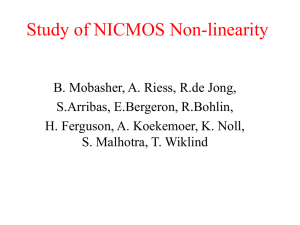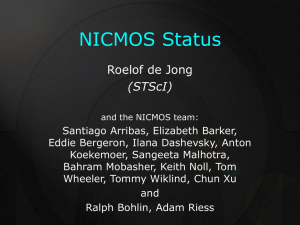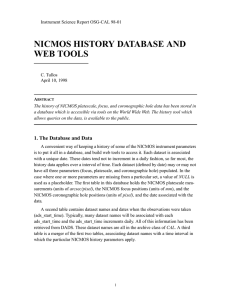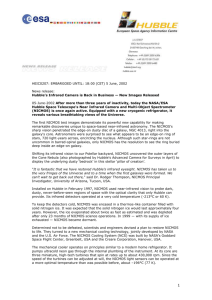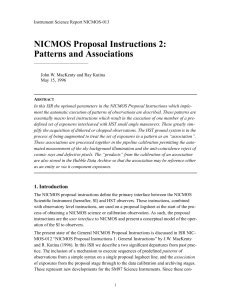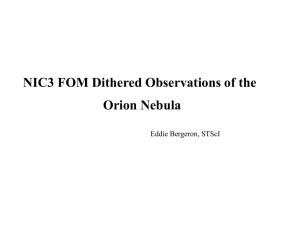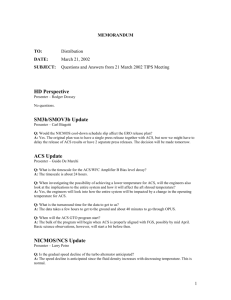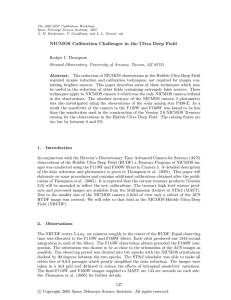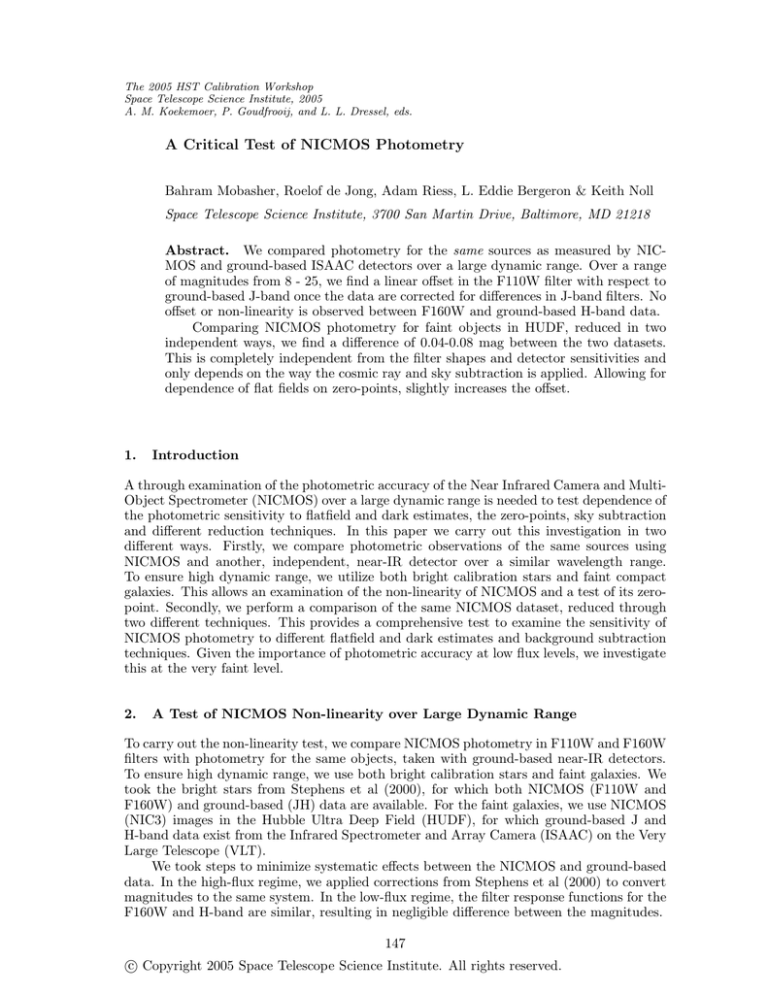
The 2005 HST Calibration Workshop
Space Telescope Science Institute, 2005
A. M. Koekemoer, P. Goudfrooij, and L. L. Dressel, eds.
A Critical Test of NICMOS Photometry
Bahram Mobasher, Roelof de Jong, Adam Riess, L. Eddie Bergeron & Keith Noll
Space Telescope Science Institute, 3700 San Martin Drive, Baltimore, MD 21218
Abstract. We compared photometry for the same sources as measured by NICMOS and ground-based ISAAC detectors over a large dynamic range. Over a range
of magnitudes from 8 - 25, we find a linear offset in the F110W filter with respect to
ground-based J-band once the data are corrected for differences in J-band filters. No
offset or non-linearity is observed between F160W and ground-based H-band data.
Comparing NICMOS photometry for faint objects in HUDF, reduced in two
independent ways, we find a difference of 0.04-0.08 mag between the two datasets.
This is completely independent from the filter shapes and detector sensitivities and
only depends on the way the cosmic ray and sky subtraction is applied. Allowing for
dependence of flat fields on zero-points, slightly increases the offset.
1.
Introduction
A through examination of the photometric accuracy of the Near Infrared Camera and MultiObject Spectrometer (NICMOS) over a large dynamic range is needed to test dependence of
the photometric sensitivity to flatfield and dark estimates, the zero-points, sky subtraction
and different reduction techniques. In this paper we carry out this investigation in two
different ways. Firstly, we compare photometric observations of the same sources using
NICMOS and another, independent, near-IR detector over a similar wavelength range.
To ensure high dynamic range, we utilize both bright calibration stars and faint compact
galaxies. This allows an examination of the non-linearity of NICMOS and a test of its zeropoint. Secondly, we perform a comparison of the same NICMOS dataset, reduced through
two different techniques. This provides a comprehensive test to examine the sensitivity of
NICMOS photometry to different flatfield and dark estimates and background subtraction
techniques. Given the importance of photometric accuracy at low flux levels, we investigate
this at the very faint level.
2.
A Test of NICMOS Non-linearity over Large Dynamic Range
To carry out the non-linearity test, we compare NICMOS photometry in F110W and F160W
filters with photometry for the same objects, taken with ground-based near-IR detectors.
To ensure high dynamic range, we use both bright calibration stars and faint galaxies. We
took the bright stars from Stephens et al (2000), for which both NICMOS (F110W and
F160W) and ground-based (JH) data are available. For the faint galaxies, we use NICMOS
(NIC3) images in the Hubble Ultra Deep Field (HUDF), for which ground-based J and
H-band data exist from the Infrared Spectrometer and Array Camera (ISAAC) on the Very
Large Telescope (VLT).
We took steps to minimize systematic effects between the NICMOS and ground-based
data. In the high-flux regime, we applied corrections from Stephens et al (2000) to convert
magnitudes to the same system. In the low-flux regime, the filter response functions for the
F160W and H-band are similar, resulting in negligible difference between the magnitudes.
147
c Copyright 2005 Space Telescope Science Institute. All rights reserved.
148
Mobasher et al.
Figure 1: Comparison between NICMOS (F110W) and ground-based J-band photometry
for stars (top panel) and galaxies (bottom panel). Stars are taken from Stephens et al (2000)
and galaxies from HUDF with available NICMOS and ground-based data. Flat horizontal
line at 0 represents agreement between magnitudes for point source (stars) and extended
(galaxies) objects. The green line represents the data binned in magnitude intervals. All
the magnitudes are corrected for differences between the filter response functions.
Figure 2: The same as Figure 1 for F160W filter.
A Critical Test of NICMOS Photometry
149
However, the F110W filter extends to shorter wavelengths than the standard ISAAC
J-band, making a direct comparison more difficult. We corrected for this using known
photometric redshifts and spectral types for HUDF galaxies and estimating corrections
to magnitudes, ranging from 0.2 to 0.6 magnitude, using their best-fit Spectral Energy
Distributions.
We compare photometry for F110W vs. J (Figure 1) and F160W vs. H (Figure 2)
over a dynamic range from 8 to 25 magnitude. The faintest six magnitudes over this range
are mostly dominated by background counts. In the case of F160W, the magnitudes from
the two detectors agree quite well, demonstrating good consistency for F160W photometry.
Moreover, the continuity between the magnitudes for stars and galaxies is better than 0.1
magnitude. We find the NICMOS F110W magnitudes are consistent with ground-based
J-band data in the low-flux regime, after reducing dispersion in magnitudes by averaging
a large number of objects, divided into magnitude intervals. This comparison depends on
the accuracy of photometric transformations, corrections due to differences in filter response
functions and matching the apertures between the ground-based and NICMOS observations.
In the high flux regime, the F110W magnitudes are 5-10% fainter than ground-based J-band
magnitudes.
The main cause of the excess faintness for NICMOS magnitudes, also found by Bohlin,
Linder & Riess (2005), is due to a non-linearity in NICMOS photometry, as is recently
confirmed by de Jong et al. Using the recently obtained NICMOS data, the size of the
non-linearity is now calibrated.
3.
NICMOS Photometric Comparison From Different Reduction Techniques
There are two versions of the NICMOS HUDF data, reduced completely independently
by Thompson et al (2005) and Robberto et al (2006). The images are reduced following
standard procedure, using library flat fields and dark images. The main difference between
the two reduction procedures is the cosmic ray removal and sky subtraction techniques.
Robberto et al (2006) uses an iterative technique to perform cosmic ray removal and sky
subtraction while Thompson et al (2005) generate the median filter image from all the
HUDF NICMOS observations and use that as the background image. In order to compare
the resulting photometric data from the two reduced images, we perform photometry on
both the images in exactly the same way.
We used SExtractor to detect sources from Robberto et al (2006). We then performed
aperture photometry on the position of the detected sources on both Thompson et al/ and
Robberto et al/ images. We used the same aperture size, local background subtraction procedure and zero-points. We compare the results from the two analysis in Figures 3 (J-band)
and 4 (H-band). In this analysis the difference between the two measurements is entirely
due to the reduction techniques used by the two teams. We find a difference of 0.04-0.08
mag in the photometry of faint galaxies, resulting from differences in the reduction techniques. One source of uncertainty here is that due to dependence of zero-points on flat fields,
one needs to use consistent zero-points. This might be the case as Thompson’s reduction
used old zero-points, calculated before installation of the NICMOS Cooling System. Using
consistent photometric zero-points slightly increases the offset between J (Figure 3- bottom
panel) and H (Figure 4- bottom panel) band magnitudes.
4.
Conclusions
We compared photometry for the same sources as measured by NICMOS and ground-based
ISAAC detectors over a large dynamic range. Over a range of 8-25 magnitudes, we find
a linear offset in the F110W filter with respect to ground-based J-band once the data are
150
Mobasher et al.
Figure 3: Comparison between two independent reductions of the HUDF NICMOS data
from Robberto et al (2006)-(STScI) and Thompson et al (2005)- (Thompson). The magnitudes are measured over 10 pixel diameter with only the brighter objects used. Top Panel:
the same photometric zero-points are used. Bottom Panel: photometric zero-points were
used consistent with the data
A Critical Test of NICMOS Photometry
Figure 4: The same as Figure 3, for the F160W band.
151
152
Mobasher et al.
corrected for differences in J-band filters. No offset or non-linearity is observed between
F160W and ground-based H-band data.
Comparing NICMOS photometry for faint objects in HUDF, reduced in two independent ways, we find a difference of 0.04-0.08 mag between the two datasets. This is completely
independent from the filter shapes and detector sensitivities and only depends on the way
the cosmic ray and sky subtraction is applied. Allowing for dependence of flat fields on
zero-points slightly increases the offset.
References
Bohlin, R., Lindler, D. J. & Riess, A. 2005, Instrument Science Report NICMOS 2005-00
(Baltimore: STScI), available through http://www.stsci.edu/hst/nicmos
Robberto et al. 2006, in preparation
Stephens, A. W., Frogel, J. A., Ortolani, S., Davies, R., Joblonea, P. Renzini, A., Rich, R.
2000 ApJ 119, 419
Thompson, R. et al Astron. J. 2005

